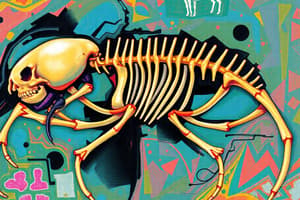Podcast
Questions and Answers
What is a primary function of the Autonomic Nervous System?
What is a primary function of the Autonomic Nervous System?
- Supplies skeletal muscle for voluntary control
- Forms numerous peripheral plexuses in skeletal muscle
- Regulates autonomic function without conscious control (correct)
- Regulates conscious movements and reflexes
Which of the following is NOT a characteristic of the Somatic Nervous System?
Which of the following is NOT a characteristic of the Somatic Nervous System?
- Motor nerves are myelinated
- Contains peripheral ganglia (correct)
- Supplies skeletal muscle
- Synapses are located within the cerebrospinal axis
What type of fibers conduct sensory impulses from the viscera to the central nervous system?
What type of fibers conduct sensory impulses from the viscera to the central nervous system?
- Efferent Fibers
- Sympathetic Fibers
- Somatic Afferent Fibers
- Visceral Afferent Fibers (correct)
Which statement about neurotransmission in the Autonomic Nervous System is correct?
Which statement about neurotransmission in the Autonomic Nervous System is correct?
Which characteristic distinguishes the sympathetic pathway from the parasympathetic pathway?
Which characteristic distinguishes the sympathetic pathway from the parasympathetic pathway?
Which statement accurately describes the neurotransmitter used by postganglionic sympathetic fibers?
Which statement accurately describes the neurotransmitter used by postganglionic sympathetic fibers?
What is a unique feature of the sympathetic nervous system compared to the parasympathetic nervous system?
What is a unique feature of the sympathetic nervous system compared to the parasympathetic nervous system?
Which characteristic distinguishes visceral afferent fibers associated with cranial nerves?
Which characteristic distinguishes visceral afferent fibers associated with cranial nerves?
What is the primary function of the myenteric plexus in the enteric nervous system?
What is the primary function of the myenteric plexus in the enteric nervous system?
What anatomical feature is associated with the parasympathetic nervous system?
What anatomical feature is associated with the parasympathetic nervous system?
Which cranial nerve carries parasympathetic efferent fibers to the lower oropharynx and organs in the thoracic and abdominal cavities?
Which cranial nerve carries parasympathetic efferent fibers to the lower oropharynx and organs in the thoracic and abdominal cavities?
What is the role of nitric oxide in the autonomic nervous system?
What is the role of nitric oxide in the autonomic nervous system?
How do the sympathetic and parasympathetic systems differ in their target cell communication?
How do the sympathetic and parasympathetic systems differ in their target cell communication?
What is the function of the submucosal plexus in the enteric nervous system?
What is the function of the submucosal plexus in the enteric nervous system?
Which type of ganglia is characterized by being close to the organs they innervate in the autonomic nervous system?
Which type of ganglia is characterized by being close to the organs they innervate in the autonomic nervous system?
What effect do neurotransmitters have on male sexual organs in relation to their function?
What effect do neurotransmitters have on male sexual organs in relation to their function?
During axonal conduction, what is the resting potential of a neuron?
During axonal conduction, what is the resting potential of a neuron?
Which neurotransmitters are found in nerve endings that have the ability to depolarize or hyperpolarize postsynaptic cells?
Which neurotransmitters are found in nerve endings that have the ability to depolarize or hyperpolarize postsynaptic cells?
What phenomenon occurs in myelinated fibers that allows for rapid signal transmission?
What phenomenon occurs in myelinated fibers that allows for rapid signal transmission?
What is a major consequence of Batrachotoxin affecting neuronal function?
What is a major consequence of Batrachotoxin affecting neuronal function?
What occurs during the first phase of action potential generation?
What occurs during the first phase of action potential generation?
What role does Tetrodotoxin play in neuronal conduction?
What role does Tetrodotoxin play in neuronal conduction?
In neurotransmission across the synapse, what initiates the transmission of an excitatory or inhibitory impulse?
In neurotransmission across the synapse, what initiates the transmission of an excitatory or inhibitory impulse?
Flashcards are hidden until you start studying
Study Notes
Visceral Afferent Fibers
- Mechanoreceptor and chemosensory information are conveyed via visceral afferent fibers.
- Sensations carried include temperature and tissue injury from mechanical or thermal origins.
- Cranial nerves involved:
- CN V (trigeminal) - face and head
- CN VII (facial) - tongue
- CN IX (glossopharyngeal) - hard palate, upper oropharynx
- CN X (vagus) - lower oropharynx, larynx, trachea, esophagus, thoracic and abdominal organs.
Peripheral Autonomic System (Efferent)
- Divided into two main branches:
- Sympathetic (Thoracolumbar Outflow)
- Parasympathetic (Craniosacral Outflow).
- Neurotransmitters:
- Acetylcholine (ACh) - all preganglionic fibers; most postganglionic parasympathetic; some postganglionic sympathetic nerves.
- Nitric Oxide (NO) - some postganglionic parasympathetic nerves.
- Norepinephrine (NE) - primary postganglionic sympathetic neurotransmitter.
Sympathetic Nervous System
- Extends from T1 to L2 or L3 segments of the spinal cord.
- Ganglia types include:
- Paravertebral ganglia: white rami carry preganglionic myelinated fibers; gray rami carry postganglionic fibers.
- Prevertebral ganglia: include celiac, superior mesenteric, aorticorenal, and inferior mesenteric ganglia.
- Terminal ganglia associated with urinary bladder and rectum, located near their target organs.
- Adrenal medulla acts similarly to the sympathetic nervous system, releasing epinephrine.
Parasympathetic Nervous System
- Major cranial nerves involved: CN III, CN VII, CN IX, and CN X.
- Sacral outflow emerges from S2 to S4, forming pelvic nerves that synapse in terminal ganglia within organs such as the bladder and rectum.
Enteric Nervous System
- Comprises two nerve plexuses:
- Myenteric (Auerbach's) plexus: regulates contraction and relaxation of GI smooth muscle.
- Submucosal (Meissner's) plexus: manages secretory and absorptive functions of GI epithelium.
Comparative Features of Nervous Systems
- Sympathetic System:
- Terminal ganglia located far from effector cells.
- Preganglionic fibers use ACh; postganglionic fibers primarily use NE.
- Parasympathetic System:
- Terminal ganglia located near or within organs.
- Preganglionic fibers use ACh; postganglionic fibers use ACh via muscarinic receptors.
- Somatic System:
- Innervates skeletal muscles directly without ganglionic relay; utilizes myelinated fibers.
Neurotransmission
- Defined as the release and action of neurotransmitters from presynaptic neurons to activate receptors on postsynaptic neurons.
- Autonomic Nervous System operates without conscious control, regulating involuntary bodily functions and supplying all structures except skeletal muscles.
- Distal synapses occur outside the cerebrospinal axis; postganglionic nerves are typically nonmyelinated.
Steps of Neurotransmission
- Action potential leads to impulse conduction along axons.
- Resting potential is about -70mV with major ions being K+ intracellularly and Na+ extracellularly.
- Action potential consists of initial Na+ influx followed by K+ inactivation and delayed opening, leading to propagation of the signal.
- Myelinated fibers use saltatory conduction via nodes of Ranvier.
Toxins and Effects on Neurotransmission
- Tetrodotoxin and Saxitoxin block Na+ channels, preventing action potentials.
- Batrachotoxin increases Na+ channel permeability leading to persistent depolarization and paralysis.
- Scorpion toxins can also induce persistent depolarization by inhibiting Na+ channel inactivation.
Junctional Transmission
- Initiated by action potentials at axon terminals, facilitating the transfer of impulses across synapses or neuroeffector junctions.
Studying That Suits You
Use AI to generate personalized quizzes and flashcards to suit your learning preferences.





